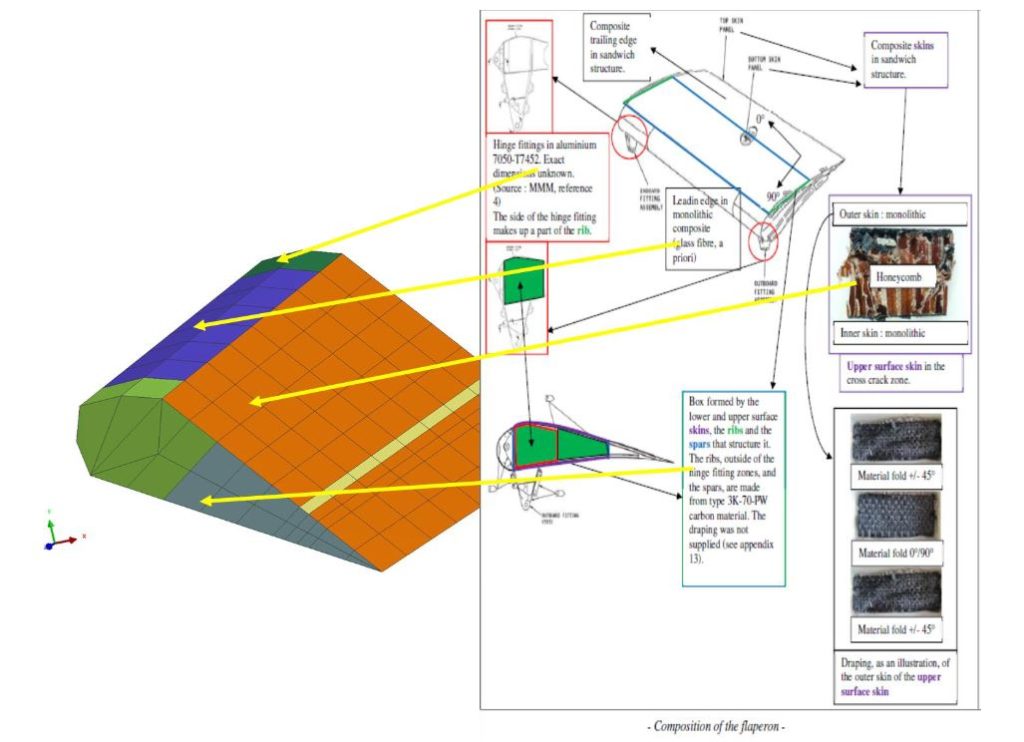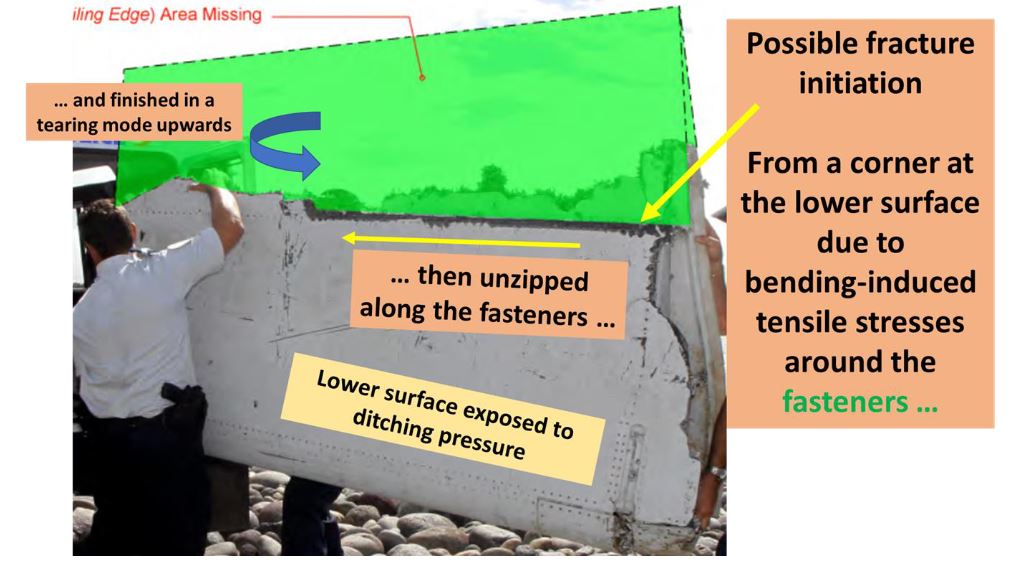The Flaperon
How was the first impact of the MH370 Flaperon with the sea ?
A very small amount of debris has been recovered from the coasts of the Indian Ocean, Africa, Mauritius and Reunion Island. Only three pieces of debris have been formally identified: the right flaperon, the inner part of the outer right flap and the trailing edge of the left outer flap.
The right flaperon, recovered from the island of Reunion, was transmitted to a laboratory of the DGA. DGA stands for General Delegation to Armament. It is still there because of the French judicial investigation, still ongoing. However, a structural study by this laboratory was incorporated into the final investigation report. It was published by the Malaysian authorities in July 2018.
The MH370 right flaperon is the only piece of debris, among the three identified, that has ever been analyzed by Authorities.
I (within the CAPTIO team) performed my own analysis using the information publicly available from the French Authorities. I published it jointly with CAPTIO in the 3AF Issue n°40 – 03/2020 magazine. The highlights are here, which are in agreement with the findings of the Investigation Report of the DGA Experts. They give credence to the hypothesis of a ditching during the last moments of the missing aircraft.
I first established that if the flaperon during ditching would had stayed “in one piece”, it would had experienced forces so huge that it would had been impossible to physically sustain the water impact. The image below shows this unrealistic scenario for the flaperon ditching.

Hence, material elasticity and fracture should be necessary ingredients of any computer assisted modelling. The only way to reveal the way it would break. The image below gives an idea of the associated complexity of the materials that comprised the flaperon. They were metallic, filamentary composites and honeycombs.

I therefore analyzed the flaperon using the elastic model with the modeling of the material damage. It was characterized from information related to the materials above. The result shown in the figure below gives evidence to the fracture of the trailing edge. It was just after the trailing edge spar. It compares rather favourably with the discovered flaperon.

The image below offers such a comparison with the evidence found.

My inspiration to perform the MH370 flaperon simulation scenarios came from the work of the DGA researchers. They had speculated that the ditching of the flaperon could have resulted in fracture of the trailing edge. They also speculated that a free fall would have shown a leading edge first impact associated damage. As mentioned in the DGA report, the flaperon’s Center of Gravity (CG) is well ahead of its centroid. The force of gravity would therefore tend to produce a pitching down moment. The associatred form drag would act further back.
The idea of a free fall leading to a water impact comes from the following suggestion: An uncontrollable dive of the aircraft occurred with strong aeroelastic instabilities. The wing could not sustain the flaperon attached to it any more. The flaperon will then break loose from the wing during the descend. I estimated that for a release at 5000 feet and 400 km/hour longitudinal speed with a mass of 50 kg. The sectional properties for the drag coefficient were from the FoilSim NASA program. I estimated that it will have a terminal speed (impact speed) of 38 m/sec (137 km/hour). Also an impact angle of 50 degrees nose-down as in the figure below.

One can see that there is a significant possibility for damage at the leading edge. The image below shows the comparison with the evidence.

One can clearly see that only guided ditching (or a similar scenario) produces damage and rupture on the trailing edge. The free fall scenario, according to the DGA report’s assumptions, favours more localized damage close to the leading edge.
With respect to the flaperon’s trailing edge failure scenario, figure below presents the most obvious outcome of this investigation.

I finally embarked in 2020 to investigate theoretically the response of the flaperon under guided ditching conditions. This is what we call “first impact” type of analysis. I published the findings with a scientific paper in the AIAA AVIATION 2020 FORUM. The outcome of this theoretical investigation was the following. Derive the locus of combinations of aircraft horizontal and vertical speeds that would break the trailing edge of the flaperon. This upon guided ditching and as a function of the flaperon angle to the sea surface. I estimated the fracture of the trailing edge by taking the stress concentrations around the fasteners into account. This gave rise to the “unzipping” crack propagation scenario of the previous figure.

Each of the above curves corresponds to a particular flaperon inclination to the sea surface, which might mean many different configurations. For instance flaperon at 30 degrees might mean:
- sea-surface calm, wing horizontal, flaperon extended at 30 degrees
- sea-surface calm, wing at 15 degrees, flaperon extended at 15 degrees
- sea-surface disturbed with ascending wave crest of 15 degrees, either wing at 15 degrees and flaperon extended at 30 degrees, or wing horizontal and flaperon extended at 45 degrees (if possible …)
The above curves show that the cases where the flaperon trailing edge will not break correspond mostly to an extended flaperon at low horizontal and vertical speeds that do not correspond to any flying conditions; any ditching configuration will almost certainly damage and/or break the flaperon trailing edge.
The findings of this investigation reinforced my belief that the final moments of the MH370 most likely involved a guided ditching, that is, somehow someone piloted the aircraft to the very end. This led me to investigate what type of potential water impact configuration the MH370 would have had, which would result in the rest of the flaperon to be detached from the wing. I discuss this in the following section, however it is ongoing.